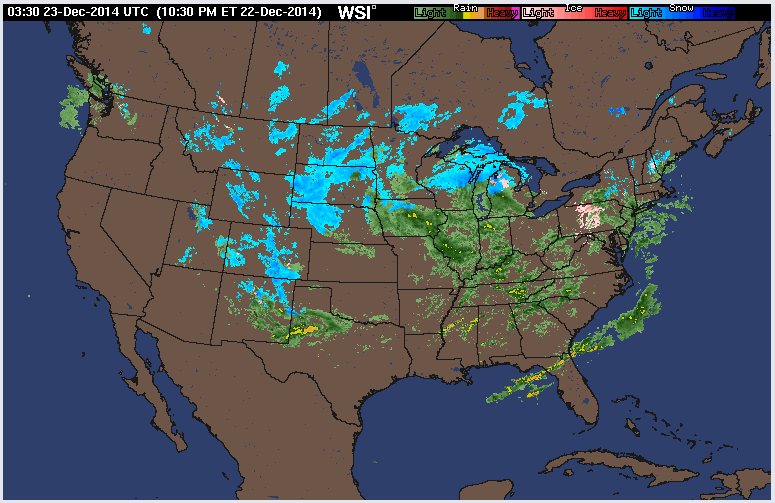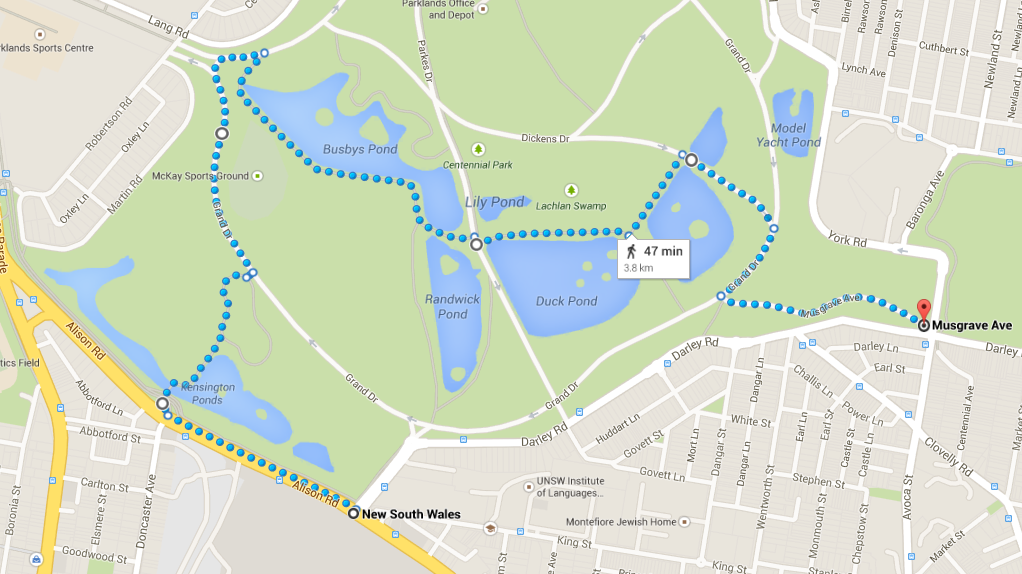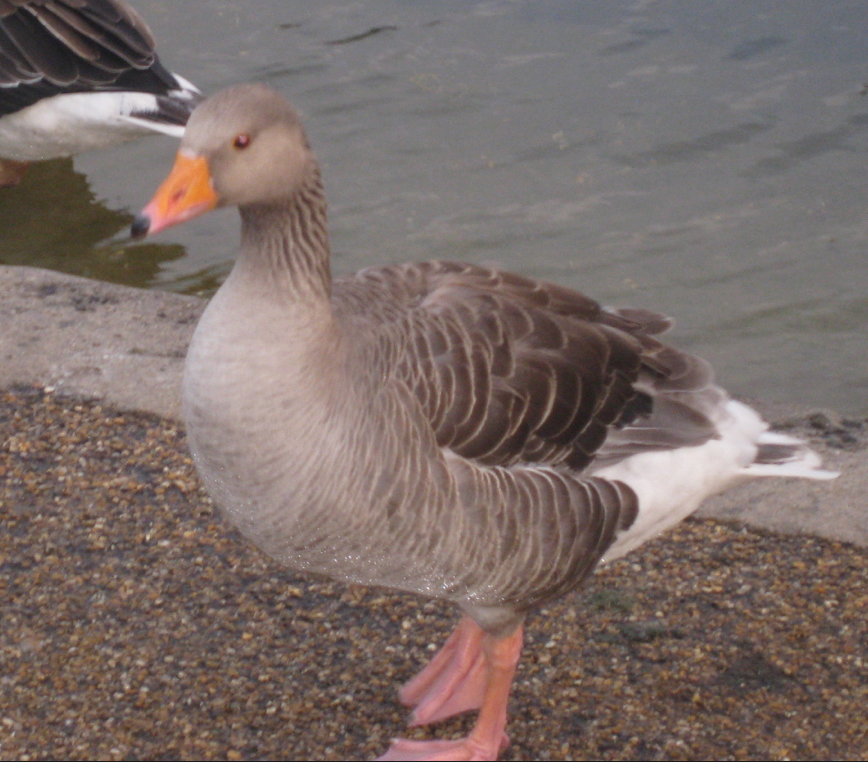With the sun high in the sky, a healthy brekkie of yogurt and muesli in my belly, and Matt at work, I set out for a walk in Centennial Park.
My walk through the park (Google Maps).
I begin by travelling along the narrow strip of park between Kensington Ponds and Allison Road. A father and his kids are admiring some birds on the other side of the pond, and I peer through my binoculars to see what they are -
Eurasian coots,
Pacific black ducks, and
Australian white ibises. These are all birds commonly sighted in the Park, so I move on, past some
starlings pecking in the grass.
Trees line the path, standing between me and the road. An unfamiliar call from one of these trees prompts a closer examination. I stand still in the shade of the tree, awaiting a movement or sound from within. Another call from the bird directs my gaze to a flash of red and green-gray moving through the foliage. Through my binoculars I see the red ear-coverts, black head, grey throat and green body of an
Australasian Figbird - my first ever sighting! According to my bird book, Sydney is at the very bottom of the species range, but the species is mostly sedentary. I wonder why I haven't seen them here before.
Can you spot the Australasian figbird?
In a flash, the figbird flies out across the busy road towards the Randwick Royal Racecourse, and I enter Centennial Park via a footbridge over the ponds, where murky waters conceal the movements of massive fish and little swimming turtles. But I'm here today for the birds, so I move on.
I'm now in the bush and thickets between Kensington Ponds and Grand Drive, which is a less frequented area of the park (for people) but - I am hoping - I nice quiet shelter for birds. Rustlings and chirps on the ground capture my attention, but after several minutes of silent waiting, I move on. Some
pied currawongs draw my attention to a large bird on a low eucalyptus branch.
A roosting channel-billed cuckoo in Centennial Park
Through my binoculars I examine the expression of the
channel-billed cuckoo. I've only ever seen them in flight before, chasing - or being chased by - other species. Here, hanging out alone in a tree, I can appreciate its distinctive beak, red eye and beautiful black and white tail feathers. As I snap photos of the cuckoo, figbirds join the same tree and start singing. The cuckoo looks annoyed.
A channel-billed cuckoo and Australasian figbird share the same tree
The figbirds sing. Now that I can identify their call, I hear them in multiple places in the trees along the pond.
An Australasian figbird calling in Centennial Park
I press on, past birthday parties and screaming children, to the spot by the pond where I saw the father and his kids. The coots are gone. An
australasian darter fans his wings on the rocks, as a turtle sneaks ever nearer. A
little pied cormorant joins in the fun, and the more common ibises and Pacific black ducks officially feel like the middle children.
Common mynas swoop by, being their usual garrulous selves.
Darter and cormorant and ibis oh my!
I can feel the skin of my neck burning now, and I daub on some sunscreen. A chorus of
butcher birds stops me in my tracks, and I spot them in a tree. Despite their abundance, these birds can be quite elusive. When I have seen them it has often been in urban settings - sitting atop telephone wires and rooftoop antennas. It's nice to see them singing in a tree, up close through my binoculars. But they don't sit still for long. My camera battery dies.
I move on across Grand Drive, to the cricket field. There are now many more people around. Lots of birds are pecking at the ground on the edge of the field, next to a little shaded gully. A
kookaburra sits strangely still in the middle of the field and I wonder if he is hurt. Starlings,
pigeons and
magpie larks abound. A
willie wagtail puts on a show, darting back and forth between the ground and a tree, sometime splaying his wings in the grass, sometimes catching insects in mid-air. A family of
superb fairy-wrens - two breeding males and five or six females and juveniles - emerges from the underbrush and hops across the grass into the distance. Two
Australian pelicans swirl overhead, headed - I presume - for Busby's Pond. Butcherbirds can be heard to the west.
I walk along the path, past a flock of
magpies, towards Busby's Pond.
Crested pigeons purr and
noisy miners yawp. I walk east along the south side of Busby's Pond. A pair of
lorikeets flies over my head and plays in a nearby tree. On the pond,
purple swamphens and
dusky moorhens swim with Pacific black and
hardhead ducks. Ibises and australasian darters roost in trees. A little pied cormorant dries his wings next to some pelicans and
domestic geese.
Welcome swallows in Vernon Pavilion
Australian ravens are calling overhead, and I snap a few pictures. I stop for lunch at Vernon Pavilion, enjoying my hot dog under the
welcome swallows, who roost in the pavilion's eaves and build mud nests high in the rafters.
Black swans and
silver gulls can be heard out on the Duck Pond, where
little black cormorants dive for fish.
I travel east above the Duck Pond, to the noisy Lachlan Swamp, where hundreds of flying foxes cling to the treetops above. I follow a pair of grey butcherbirds through the swamp, being careful to avoid the yellow flying fox droppings that occasionally fall. Some noisy miners join in. I linger in the swamps, pressing my luck with the flying fox droppings (one drops dangerously close to me), with the hopes of seeing a tawny frogmouth. Because they are active at night and camouflaged during the day, I have never seen one. Today will not be the day.
In the swamps - can you spot the grey butcherbird?
When I emerge from the swamps, water falls in drops from the sky. Grey clouds loom overhead. Usually my faithful currawongs sound their alarm to tell me the rain is coming. I suppose they don't frequent the swamps. Picnickers pack up their blankets and food, and a line of cars builds up along Grand Drive as I hop from tree to tree to shield myself from the rain, which now falls more heavily. I am not in any hurry. It will take me about 30 minutes to walk home, but my binoculars and camera will stay dry in my bag.


















































